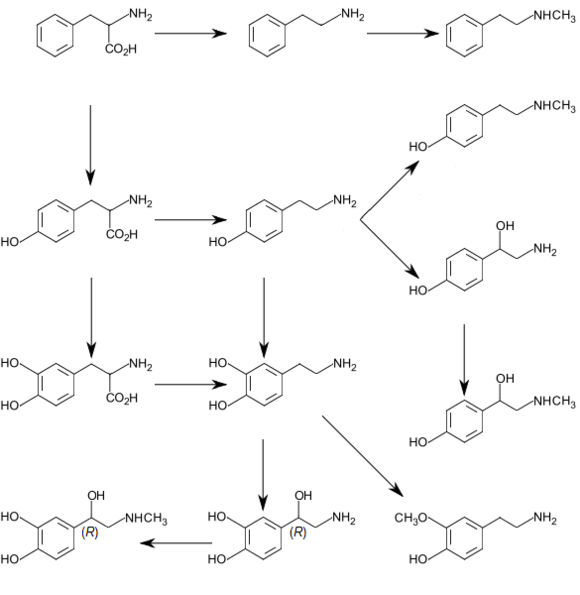Agmatine
"Agmatine has been discussed as a putative neurotransmitter/neuromodulator. It is synthesized in the brain, stored in synaptic vesicles, accumulated by uptake, released by membrane depolarization, and inactivated by agmatinase. Agmatine binds to α2-adrenergic receptor and imidazoline receptor binding sites, and blocks NMDA receptors and other cation ligand-gated channels. Short only of identifying specific ("own") post-synaptic receptors, agmatine in fact, fulfills Henry Dale's criteria for a neurotransmitter and is hence, considered a neuromodulator and co-transmitter. But identification of agmatinergic neuronal systems, if exist, still awaits future research."
"Agmatine has several mechanisms. It can inhibit N-methyl-D-aspartate (NMDA) and nicotinic acetylcholine receptors, as well as activate imidazoline receptors. Agmatine can also inhibit nitric oxide synthase enzymes, which allows it to regulate elevated levels of nitric oxide. Agmatine can inhibit calcium channels and certain serotonin receptors as well. Further research is needed to determine the full extent of agmatines mechanisms."
3.9. Opioidergic Neurotransmission
The activation of imidazoline receptors (specifically I2 receptors) in the adrenal glands appears to induce the release of β-endorphin (a naturally produced opioidergic pain killer)[92] which has central and peripheral implications.
Enhancement of opioidergic analgesia[123] and the attenuation of tolerance development[141] have been noted with NMDA antagonists before (possible role of Agmatine) although one study has noted that the prevention of tolerance was reliant on activation of imidazoline receptors.[142]
Agmatine is able to release some opioids inherently by activating imidazoline receptors in the adrenal glands. So in regards to the following information of how agmatine interacts with opioids (which should apply to β-endorphin as well), it is somewhat synergistic with itself in persons with functioning adrenals
The acute analgesic (pain killing) effects of morphine are augmented when coadministered with agmatine,[143] which is mediated by α2A receptors[144] and appears to extend to oxycodone[145] and fentanyl (two other opioidergic drugs similar to morphine).
For acute analgesia, agmatine appears to be synergistic with opioids
Agmatine has been found to potently inhibit tolerance to μ-opioid agonists (Endo-2 and DAMGO-AG) with intrathecal injections of 4nmol[112] which appears to be effective for up to 48 hours following a single dose.[112] This has also been noted in rhesus monkeys given oral agmatine (40-80mg/kg).[146]
Tolerance to opioidergic drugs has been noted to be reduced in research animals.[143][120]
Tolerance to opioids (the reduction of efficacy that comes with prolonged usage) appears to be attenuated when agmatine is coadministered, which would synergistically preserve the analgesic effects of opioids
Adrenergic receptors are involved with opioid receptors, with activation of the α2A receptor[147][148] and inhibition of β-adrenergic receptors being able to attenuate morphine withdrawal symptoms;[149] conversely, Yohimbine (inhibitor of α2A) negatively augments withdrawal symptoms.[150][151]
In studies that measure addictive properties (self-administration usually what is investigated) or withdrawal symptoms of opioidergic drugs, agmatine has been noted to reduce self-administration of fentanyl.[152][153]
In regards to conditioned place preference (CPP; a preference for one place over another thought to be a biomarker of addictive behaviour[154]), agmatine cotreatment with morphine is able to augment morphine-induced conditioned place preference.[155]
3.18. Calcium signalling
Agmatine has a few interactions with calcium signalling. Firstly, NMDA receptor activation tends to increase intracellular calcium which can then activate nNOS[266][267] and via being an NDMA antagonist[105] agmatine can limit the increase in calcium (agmatine can act on nNOS in more than just this way, however). Furthermore, agmatine has been noted to block calcium channels directly on hippocampal neurons in a reversible manner with an IC50 value of 0.79-1.57µM and recorded 21+/-4% inhibition at a concentration of 100nM[225] but elsewhere has been noted to displace the calcium channel blocker known as Diltiazem.[268]
Agmatine has failed to have any influence on sodium or potassium channels at concentrations of up to 500µM.[225] That being said, nitric oxide has been noted to increase the activity of calcium-activated potassium channels[269][270] which is downstream of NMDA activation;[271] this presumes an inhibitory effect of agmatine on potassium channels (as it is an NMDA antagonist), which is thought to at least in part contribute to antidepressant effects.[215]
I'm taking 1.5 grams agmatine in this stack a day minimum
Huperazine a:
Pharmacological effects[edit]
Huperzine A is extracted from Huperzia serrata.[1] It is an acetylcholinesterase inhibitor[4][5] and NMDA receptor antagonist.[6] The structure of the complex of huperzine A with acetylcholinesterase has been determined by X-ray crystallography (PDB code: 1VOT; see the 3D structure).[7]
Neuroscience. 2001;105(3):663-9.
Huperzine A, a nootropic alkaloid, inhibits N-methyl-D-aspartate-induced current in rat dissociated hippocampal neurons.
Zhang JM1, Hu GY.
Author information
Abstract
Huperzine A, a nootropic alkaloid isolated from a Chinese herb, has been proposed as one of the most promising agents to treat Alzheimer's disease. Recently, the agent was found to inhibit the N-methyl-D-aspartate (NMDA) receptors in rat cerebral cortex in addition to causing an inhibitory effect on acetylcholinesterase. In the present study, the mechanisms underlying NMDA receptor inhibition were investigated using whole-cell voltage-clamp recording in CA1 pyramidal neurons acutely dissociated from rat hippocampus. Huperzine A reversibly inhibited the NMDA-induced current (IC(50)=126 microM, Hill coefficient=0.92), whereas it had no effect on the current induced by alpha-amino-3-hydroxy-5-methyl-4-isoxazole propionate or kainate. The effect was non-competitive, and showed neither 'voltage-dependency', nor 'use-dependency'. The IC(50) values of huperzine A were neither altered by changing the concentrations of glycine (2-0.2 microM) and pH (7.4-6.7) in the external solution, nor by addition of Zn(2+) (5 microM) and dithiothreitol (5 mM) to the external solution. However, addition of spermine (200 microM) to the external solution caused a parallel shift to the right of the huperzine A concentration-response curve. From these we suggest that huperzine A acts as a non-competitive antagonist of the NMDA receptors, via a competitive interaction with one of the polyamine binding sites. The potential relevance of NMDA receptor antagonist activity of huperzine A to the treatment of Alzheimer's disease is discussed.
Huperzine A is a non-competitive antagonist of NMDA receptors [2] via negative allosteric modulation of the MK-801 binding site [4]. Unlike memantine, hup A's NMDA antagonism is not use- or voltage-dependent [2],
Keywords:
huperzine A;glutamate;NMDA;calcium;protection;ion channel;PCP;cholinesterase;receptors;neuroprotection
Abstract
Huperzine A (HUP-A), first isolated from the Chinese club moss Huperzia serrata, is a potent, reversible and selective inhibitor of acetylcholinesterase (AChE) over butyrylcholinesterase (BChE) (Life Sci. 54: 991997). Because HUP-A has been shown to penetrate the bloodbrain barrier, is more stable than the carbamates used as pretreatments for organophosphate poisoning (OP) and the HUP-A:AChE complex has a longer half-life than other prophylactic sequestering agents, HUP-A has been proposed as a pretreatment drug for nerve agent toxicity by protecting AChE from irreversible OP-induced phosphonylation. More recently (NeuroReport8: 963968), pretreatment of embryonic neuronal cultures with HUP-A reduced glutamate-induced cell death and also decreased glutamate-induced calcium mobilization. These results suggest that HUP-A might interfere with and be beneficial for excitatory amino acid overstimulation, such as seen in ischemia, where persistent elevation of internal calcium levels by activation of the N-methyl-d-aspartate (NMDA) glutamate subtype receptor is found. We have now investigated the interaction of HUP-A with glutamate receptors. Freshly frozen cortex or synaptic plasma membranes were used, providing 6090% specific radioligand binding. Huperzine A (≤100 µM) had no effect on the binding of [3H]glutamate (low- and high-affinity glutamate sites), [3H]MDL 105,519 (NMDA glycine regulatory site), [3H]ifenprodil (NMDA polyamine site) or [3H]CGS 19755 (NMDA antagonist). In contrast with these results, HUP-A non-competitively (Hill slope < 1) inhibited [3H]MK-801 and [3H]TCP binding (co-located NMDA ion channel PCP site) with pseudo Ki ∼ 6 µM. Furthermore, when neuronal cultures were pretreated with HUP-A for 45 min prior to NMDA exposure, HUP-A dose-dependently inhibited the NMDA-induced toxicity. Although HUP-A has been implicated to interact with cholinergic receptors, it was without effect at 100 µM on muscarinic (measured by inhibition of [3H]QNB or [3H]NMS binding) or nicotinic [3H]epibatidine binding) receptors; also, HUP-A did not perturb adenosine receptor binding [3H]PIA or [3H]NECA). Therefore, HUP-A most likely attenuates excitatory amino acid toxicity by blocking the NMDA ion channel and subsequent Ca2+ mobilization at or near the PCP and MK-801 ligand sites. Thus, on the one hand, HUP-A could be used as a pretreatment against OPs and it might also be a valuable therapeutic intervention in a variety of acute and chronic disorders by protecting against overstimulation of the excitatory amino acid pathway. By blocking NMDA ion channels without psychotomimetic side-effects, HUP-A may protect against diverse neurodegenerative states observed during ischemia or Alzheimer's disease. Copyright © 2001 John Wiley & Sons, Ltd.
I'm taking 200 mcg huperazine-a Bid with 500 mg Agmatine Tid along with 2048mg magnesium l threonate and , 120 mg (pm only) Lithium orotate too complete my stack , will post evidence of magteins superior nmda modulation and inhibition
[11]













































